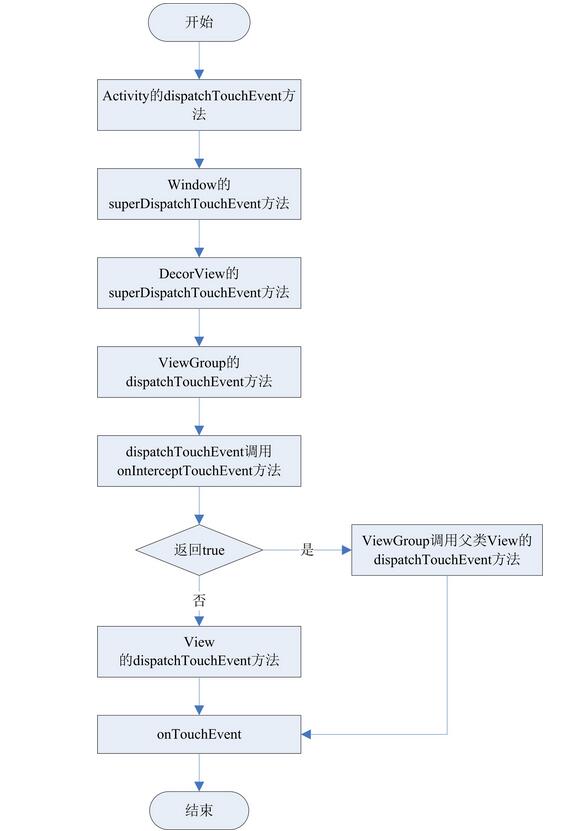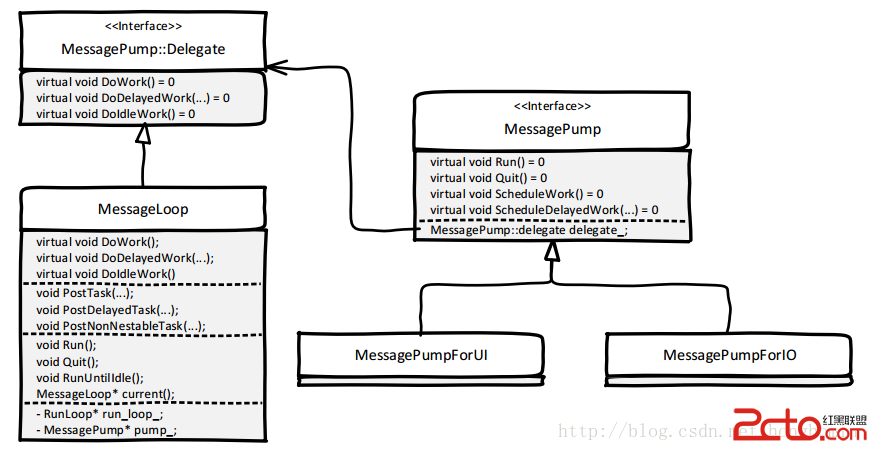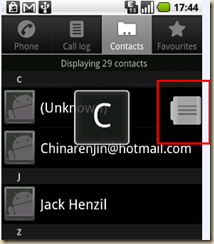編輯:關於Android編程
綜述
Android中的事件分發機制也就是View與ViewGroup的對事件的分發與處理。在ViewGroup的內部包含了許多View,而ViewGroup繼承自View,所以ViewGroup本身也是一個View。對於事件可以通過ViewGroup下發到它的子View並交由子View進行處理,而ViewGroup本身也能夠對事件做出處理。下面就來詳細分析一下ViewGroup對時間的分發處理。
MotionEvent
當手指接觸到屏幕以後,所產生的一系列的事件中,都是由以下三種事件類型組成。
1. ACTION_DOWN: 手指按下屏幕
2. ACTION_MOVE: 手指在屏幕上移動
3. ACTION_UP: 手指從屏幕上抬起
例如一個簡單的屏幕觸摸動作觸發了一系列Touch事件:ACTION_DOWN->ACTION_MOVE->…->ACTION_MOVE->ACTION_UP
對於Android中的這個事件分發機制,其中的這個事件指的就是MotionEvent。而View的對事件的分發也是對MotionEvent的分發操作。可以通過getRawX和getRawY來獲取事件相對於屏幕左上角的橫縱坐標。通過getX()和getY()來獲取事件相對於當前View左上角的橫縱坐標。
三個重要方法
public boolean dispatchTouchEvent(MotionEvent ev)
這是一個對事件分發的方法。如果一個事件傳遞給了當前的View,那麼當前View一定會調用該方法。對於dispatchTouchEvent的返回類型是boolean類型的,返回結果表示是否消耗了這個事件,如果返回的是true,就表明了這個View已經被消耗,不會再繼續向下傳遞。
public boolean onInterceptTouchEvent(MotionEvent ev)
該方法存在於ViewGroup類中,對於View類並無此方法。表示是否攔截某個事件,ViewGroup如果成功攔截某個事件,那麼這個事件就不在向下進行傳遞。對於同一個事件序列當中,當前View若是成功攔截該事件,那麼對於後面的一系列事件不會再次調用該方法。返回的結果表示是否攔截當前事件,默認返回false。由於一個View它已經處於最底層,它不會存在子控件,所以無該方法。
public boolean onTouchEvent(MotionEvent event)
這個方法被dispatchTouchEvent調用,用來處理事件,對於返回的結果用來表示是否消耗掉當前事件。如果不消耗當前事件的話,那麼對於在同一個事件序列當中,當前View就不會再次接收到事件。
View事件分發流程圖
對於事件的分發,在這裡先通過一個流程圖來看一下整個分發過程。

ViewGroup事件分發源碼分析
根據上面的流程圖現在就詳細的來分析一下ViewGroup事件分發的整個過程。
手指在觸摸屏上滑動所產生的一系列事件,當Activity接收到這些事件通過調用Activity的dispatchTouchEvent方法來進行對事件的分發操作。下面就來看一下Activity的dispatchTouchEvent方法。
public boolean dispatchTouchEvent(MotionEvent ev) {
if (ev.getAction() == MotionEvent.ACTION_DOWN) {
onUserInteraction();
}
if (getWindow().superDispatchTouchEvent(ev)) {
return true;
}
return onTouchEvent(ev);
}
通過getWindow().superDispatchTouchEvent(ev)這個方法可以看出來,這個時候Activity又會將事件交由Window處理。Window它是一個抽象類,它的具體實現只有一個PhoneWindow,也就是說這個時候,Activity將事件交由PhoneWindow中的superDispatchTouchEvent方法。現在跟蹤進去看一下這個superDispatchTouchEvent代碼。
public boolean superDispatchTouchEvent(MotionEvent event) {
return mDecor.superDispatchTouchEvent(event);
}
這裡面的mDecor它是一個DecorView,DecorView它是一個Activity的頂級View。它是PhoneWindow的一個內部類,繼承自FrameLayout。於是在這個時候事件又交由DecorView的superDispatchTouchEvent方法來處理。下面就來看一下這個superDispatchTouchEvent方法。
public boolean superDispatchTouchEvent(MotionEvent event) {
return super.dispatchTouchEvent(event);
}
在這個時候就能夠很清晰的看到DecorView它調用了父類的dispatchTouchEvent方法。在上面說到DecorView它繼承了FrameLayout,而這個FrameLayout又繼承自ViewGroup。所以在這個時候事件就開始交給了ViewGroup進行處理了。下面就開始詳細看下這個ViewGroup的dispatchTouchEvent方法。由於dispatchTouchEvent代碼比較長,在這裡就摘取部分代碼進行說明。
// Handle an initial down.
if (actionMasked == MotionEvent.ACTION_DOWN) {
// Throw away all previous state when starting a new touch gesture.
// The framework may have dropped the up or cancel event for the previous gesture
// due to an app switch, ANR, or some other state change.
cancelAndClearTouchTargets(ev);
resetTouchState();
}
從上面代碼可以看出,在dispatchTouchEvent中,會對接收的事件進行判斷,當接收到的是ACTION_DOWN事件時,便會清空事件分發的目標和狀態。然後執行resetTouchState方法重置了觸摸狀態。下面就來看一下這兩個方法。
1. cancelAndClearTouchTargets(ev)
private TouchTarget mFirstTouchTarget;
......
private void cancelAndClearTouchTargets(MotionEvent event) {
if (mFirstTouchTarget != null) {
boolean syntheticEvent = false;
if (event == null) {
final long now = SystemClock.uptimeMillis();
event = MotionEvent.obtain(now, now,
MotionEvent.ACTION_CANCEL, 0.0f, 0.0f, 0);
event.setSource(InputDevice.SOURCE_TOUCHSCREEN);
syntheticEvent = true;
}
for (TouchTarget target = mFirstTouchTarget; target != null; target = target.next) {
resetCancelNextUpFlag(target.child);
dispatchTransformedTouchEvent(event, true, target.child, target.pointerIdBits);
}
clearTouchTargets();
if (syntheticEvent) {
event.recycle();
}
}
}
在這裡先介紹一下mFirstTouchTarget,它是TouchTarget對象,TouchTarget是ViewGroup的一個內部類,TouchTarget采用鏈表數據結構進行存儲View。而在這個方法中主要的作用就是清空mFirstTouchTarget鏈表並將mFirstTouchTarget設為空。
2. resetTouchState()
private void resetTouchState() {
clearTouchTargets();
resetCancelNextUpFlag(this);
mGroupFlags &= ~FLAG_DISALLOW_INTERCEPT;
mNestedScrollAxes = SCROLL_AXIS_NONE;
}
在這裡介紹一下FLAG_DISALLOW_INTERCEPT標記,這是禁止ViewGroup攔截事件的標記,可以通過requestDisallowInterceptTouchEvent方法來設置這個標記,當設置了這個標記以後,ViewGroup便無法攔截除了ACTION_DOWN以外的其它事件。因為在上面代碼中可以看出,當事件為ACTION_DOWN時,會重置FLAG_DISALLOW_INTERCEPT標記。
那麼下面就再次回到dispatchTouchEvent方法中繼續看它的源代碼。
// Check for interception.
final boolean intercepted;
if (actionMasked == MotionEvent.ACTION_DOWN
|| mFirstTouchTarget != null) {
final boolean disallowIntercept = (mGroupFlags & FLAG_DISALLOW_INTERCEPT) != 0;
if (!disallowIntercept) {
intercepted = onInterceptTouchEvent(ev);
ev.setAction(action); // restore action in case it was changed
} else {
intercepted = false;
}
} else {
// There are no touch targets and this action is not an initial down
// so this view group continues to intercept touches.
intercepted = true;
}
這段代碼主要就是ViewGroup對事件是否需要攔截進行的判斷。下面先對mFirstTouchTarget是否為null這兩種情況進行說明。當事件沒有被攔截時,ViewGroup的子元素成功處理事件後,mFirstTouchTarget會被賦值並且指向其子元素。也就是說這個時候mFirstTouchTarget!=null。可是一旦事件被攔截,mFirstTouchTarget不會被賦值,mFirstTouchTarget也就為null。
在上面代碼中可以看到根據actionMasked==MotionEvent.ACTION_DOWN||mFirstTouchTarget!=null這兩個情況進行判斷事件是否需要攔截。對於actionMasked==MotionEvent.ACTION_DOWN這個條件很好理解,對於mFirstTouchTarget!=null的兩種情況上面已經說明。那麼對於一個事件序列,當事件為MotionEvent.ACTION_DOWN時,會重置FLAG_DISALLOW_INTERCEPT,也就是說!disallowIntercept一定為true,必然會執行onInterceptTouchEvent方法,對於onInterceptTouchEvent方法默認返回為false,所以需要ViewGroup攔截事件時,必須重寫onInterceptTouchEvent方法,並返回true。這裡有一點需要注意,對於一個事件序列,一旦序列中的某一個事件被成功攔截,執行了onInterceptTouchEvent方法,也就是說onInterceptTouchEvent返回值為true,那麼該事件之後一系列事件對於條件actionMasked==MotionEvent.ACTION_DOWN||mFirstTouchTarget!=null必然為false,那麼這個時候該事件序列剩下的一系列事件將會被攔截,並且不會執行onInterceptTouchEvent方法。於是在這裡得出一個結論:對於一個事件序列,當其中某一個事件成功攔截時,那麼對於剩下的一系列事件也會被攔截,並且不會再次執行onInterceptTouchEvent方法
下面再來看一下對於ViewGroup並沒有攔截事件是如何進行處理的。
final int childrenCount = mChildrenCount;
if (newTouchTarget == null && childrenCount != 0) {
final float x = ev.getX(actionIndex);
final float y = ev.getY(actionIndex);
// Find a child that can receive the event.
// Scan children from front to back.
final ArrayList<View> preorderedList = buildOrderedChildList();
final boolean customOrder = preorderedList == null
&& isChildrenDrawingOrderEnabled();
final View[] children = mChildren;
for (int i = childrenCount - 1; i >= 0; i--) {
final int childIndex = customOrder
? getChildDrawingOrder(childrenCount, i) : i;
final View child = (preorderedList == null)
? children[childIndex] : preorderedList.get(childIndex);
// If there is a view that has accessibility focus we want it
// to get the event first and if not handled we will perform a
// normal dispatch. We may do a double iteration but this is
// safer given the timeframe.
if (childWithAccessibilityFocus != null) {
if (childWithAccessibilityFocus != child) {
continue;
}
childWithAccessibilityFocus = null;
i = childrenCount - 1;
}
if (!canViewReceivePointerEvents(child)
|| !isTransformedTouchPointInView(x, y, child, null)) {
ev.setTargetAccessibilityFocus(false);
continue;
}
newTouchTarget = getTouchTarget(child);
if (newTouchTarget != null) {
// Child is already receiving touch within its bounds.
// Give it the new pointer in addition to the ones it is handling.
newTouchTarget.pointerIdBits |= idBitsToAssign;
break;
}
resetCancelNextUpFlag(child);
if (dispatchTransformedTouchEvent(ev, false, child, idBitsToAssign)) {
// Child wants to receive touch within its bounds.
mLastTouchDownTime = ev.getDownTime();
if (preorderedList != null) {
// childIndex points into presorted list, find original index
for (int j = 0; j < childrenCount; j++) {
if (children[childIndex] == mChildren[j]) {
mLastTouchDownIndex = j;
break;
}
}
} else {
mLastTouchDownIndex = childIndex;
}
mLastTouchDownX = ev.getX();
mLastTouchDownY = ev.getY();
newTouchTarget = addTouchTarget(child, idBitsToAssign);
alreadyDispatchedToNewTouchTarget = true;
break;
}
// The accessibility focus didn't handle the event, so clear
// the flag and do a normal dispatch to all children.
ev.setTargetAccessibilityFocus(false);
}
if (preorderedList != null) preorderedList.clear();
}
對於這段代碼雖然說比較長,但是在這裡面的邏輯去不是很復雜。首先獲取當前ViewGroup中的子View和ViewGroup的數量。然後對該ViewGroup中的元素進行逐步遍歷。在獲取到ViewGroup中的子元素後,判斷該元素是否能夠接收觸摸事件。子元素若是能夠接收觸摸事件,並且該觸摸坐標在子元素的可視范圍內的話,便繼續向下執行。否則就continue。對於衡量子元素能否接收到觸摸事件的標准有兩個:子元素是否在播放動畫和點擊事件的坐標是否在子元素的區域內。
一旦子View接收到了觸摸事件,然後便開始調用dispatchTransformedTouchEvent方法對事件進行分發處理。對於dispatchTransformedTouchEvent方法代碼比較多,現在只關注下面這五行代碼。從下面5行代碼中可以看出,這時候會調用子View的dispatchTouchEvent,也就是在這個時候ViewGroup已經完成了事件分發的整個過程。
if (child == null) {
handled = super.dispatchTouchEvent(event);
} else {
handled = child.dispatchTouchEvent(event);
}
當子元素的dispatchTouchEvent返回為true的時候,也就是子View對事件處理成功。這時候便會通過addTouchTarget方法對mFirstTouchTarget進行賦值。
如果dispatchTouchEvent返回了false,或者說當前的ViewGroup沒有子元素的話,那麼這個時候便會調用如下代碼。
if (mFirstTouchTarget == null) {
// No touch targets so treat this as an ordinary view.
handled = dispatchTransformedTouchEvent(ev, canceled, null,
TouchTarget.ALL_POINTER_IDS);
}
在這裡調用dispatchTransformedTouchEvent方法,並將child參數設為null。也就是執行了super.dispatchTouchEvent(event)方法。由於ViewGroup繼承自View,所以這個時候又將事件交由父類的dispatchTouchEvent進行處理。對於父類View是如何通過dispatchTouchEvent對事件進行處理的,在下篇文章中會進行詳細說明。
到這裡對於ViewGroup的事件分發已經講完了,在這一路下來,不難發現對於dispatchTouchEvent有一個boolean類型返回值。對於這個返回值,當返回true的時候表示當前事件處理成功,若是返回false,一般來說是因為在事件處理onTouchEvent返回了false,這時候變會交由它的父控件進行處理,以此類推,若是一直處理失敗,則最終會交由Activity的onTouchEvent方法進行處理。
總結
在這裡從宏觀上再看一下這個ViewGroup對事件的分發,當ViewGroup接收一個事件序列以後,首先會判斷是否攔截該事件,若是攔截該事件,則通過調用父類View的dispatchTouchEvent來處理這個事件。若是不去攔截這一事件,便將該事件下發到子View當中。若果說ViewGroup沒有子View,或者說子View對事件處理失敗,則將該事件有交由該ViewGroup處理,若是該ViewGroup對事件依然處理失敗,最終則會將事件交由Activity進行處理。
以上就是本文的全部內容,希望對大家的學習有所幫助,也希望大家多多支持本站。
 Chromium on Android: Android系統上Chromium主消息循環的實現分析
Chromium on Android: Android系統上Chromium主消息循環的實現分析
摘要:剛一開始接觸Chromium on Android時,就很好奇Chromium的主消息循環是怎麼整合到Android應用程序中的。對於Android程序來說,一旦啟
 Android動畫之二:View Animation
Android動畫之二:View Animation
如上一篇博客《Android動畫之一:Drawable Animation》所說,android動畫主要分為三大部分,上一篇博客已經講解Drawable Animatio
 Android權限控制之自定義權限
Android權限控制之自定義權限
天哪,這篇文章終於說道如何自定義權限了,左盼右盼,其實這個自定義權限相當easy。為了方便敘述,我這邊會用到兩個app作為例子示范。Permission App: use
 android開發之listView組件用法實例簡析
android開發之listView組件用法實例簡析
本文實例講述了android開發之listView組件用法。分享給大家供大家參考,具體如下:關於Android ListView組件中android:drawSelect